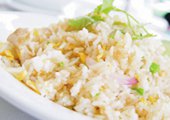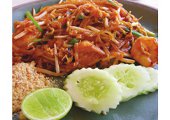

There are literally hundreds of recipes for Kaw Pad. Whether you want chicken, beef, pork, shrimp, vegetarian or even pineapple Kaw Pad, the base of all of these dishes is the same. Steamed jasmine, white or brown rice—preferably a day old—is tossed in a wok with fish sauce, garlic, scallions, eggs and tomatoes. Bean curd is also typically included in this dish. Fresh basil is added to give it that authentic Southeast Asian flavor and the dish is garnished with kaffir lime wedges and bean sprouts. Occasionally, ground peanuts or tree nuts are also used as a garnish. If you see the words “prik” or “kra prow” after Kaw Pad, you can be sure that the rice is going to be spiced with chili pepper or red curry powder.
Gluten-Free Decision Factors:
Pad See Yu is very prevalent in Thai restaurants. At the center of this simple stir-fried dish are broad rice noodles, similar to chow fun noodles found in Chinese restaurants. Pad See Yu comes with sliced chicken or beef and contains Chinese broccoli, onions and egg. The sauce is made from canola oil, fish sauce, garlic and palm sugar. Black sauce (siew dam) may also be used as a substitution for fish sauce and palm sugar. It is usually garnished with kaffir lime wedges and basil, and may additionally be garnished with chopped peanuts or tree nuts. Though Thai noodle dishes are generally lighter than most Asian noodle dishes, Pad See Yu is definitely a hearty meal. It is easily shared as an accompaniment to other menu items when eating family style.
Gluten-Free Decision Factors:

Pad Thai is by far the most popular Thai noodle dish worldwide. Pad Thai is typically made of bean curd, bean sprouts, cabbage, carrots, chicken, chili powder, fish sauce, garlic, ground peanuts, lime, onions, palm sugar, pickled radish, rice vinegar, canola oil and narrow rice noodles. Black sauce (siew dam) may also be used as a substitution for fish sauce and palm sugar. Depending on the restaurant, shrimp may also be included. The chef sautés garlic and onions with oil, adds eggs, then the other ingredients. The contents of the dish are then tossed in the wok and plated. Pad Thai is garnished with chopped peanuts or tree nuts, bean sprouts, cabbage, carrots and sliced lime. Due to the nature of its preparation, Pad Thai is always made to order. With this in mind, it is easy to omit any ingredients.
Gluten-Free Decision Factors:
Sticky rice is a fun, hands-on experience. It is prepared by first letting the rice sit in water for a day or so. This process allows the starch of the rice to expand through the shell of the grain. As a result, the rice sticks together when steamed and can be formed into any shape desired. The Thai use sticky rice to soak up the sauces or curries in their meals. This custom is sure to lighten the atmosphere of any Thai dining experience, especially when eating family style.
Gluten-Free Decision Factors: